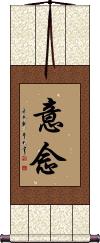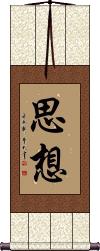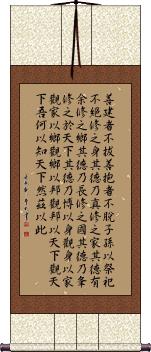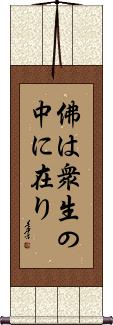Many custom options...
And formats...

Contemplate in Chinese / Japanese...
Buy a Contemplate calligraphy wall scroll here!
Personalize your custom “Contemplate” project by clicking the button next to your favorite “Contemplate” title below...
Idea / Concept
理念/理唸 means idea, notion, concept, principle, theory, philosophy*, or doctrine in Chinese, Japanese Kanji, and old Korean Hanja.
This word is OK for a wall scroll, although it's more commonly used as an oral/informal word in Asia.
* This is not the title for philosophy but rather is about having a certain philosophy or approach to something.
Idea / Thought
意見 means idea, thought, opinion, or view in Japanese.
This word also has a similar meaning in Chinese, just often used in China.
Idea / Thought
Thought / Thinking / Idea
思想 means thought, thinking, or idea in Chinese, Japanese Kanji, and old Korean Hanja. Sometimes it can mean ideology, depending on context.
This can refer to someone's personality - like saying, “he is a thinker.”
Daodejing / Tao Te Ching - Chapter 54
This is the Mawangdui version of Daodejing chapter 54.
By its virtue alone can one generation after another carry on the ancestral sacrifice.
Apply it to yourself, and by its power, you will be freed from dross.
Apply it to your household, and your household shall thereby have abundance.
Apply it to the village, and the village will be made secure.
Apply it to the kingdom, and the kingdom shall thereby be made to flourish.
Apply it to an empire, and the empire shall thereby be extended.
Therefore just as through oneself, one may contemplate Oneself;
So through the household one may contemplate the Household;
And through the village, one may contemplate the Village;
And through the kingdom, one may contemplate the Kingdom;
And through the empire, one may contemplate the Empire.
How do I know that the empire is so? By this.
What is firmly rooted cannot be pulled out;
What is tightly held in the arms will not slip loose;
Through this, the offering of sacrifice by descendants will never come to an end.
Cultivate it in your person, and its virtue will be genuine;
Cultivate it in the family, and its virtue will be more than sufficient;
Cultivate it in the hamlet, and its virtue will endure;
Cultivate it in the state, and its virtue will abound;
Cultivate it in the empire, and its virtue will be pervasive.
Hence look at the person through the person;
Look at the family through the family;
Look at the hamlet through the hamlet;
Look at the state through the state;
Look at the empire through the empire.
How do I know that the empire is like that?
By means of this.
The Buddha is in Each Sentient Being
佛は衆生の中に在り is “Butsu wa shujo no naka ni ari” and means that the Buddha (potential for Buddhahood) exists in all beings in the universe.
So yes, your dog has the potential to be a Buddha (but only in a future reincarnation as a human). But all things, from the tiny cricket to the humpback whale have Buddha nature within them. If one takes the time to look and contemplate, one will see the Buddha in all things.
In Japan, sometimes the Buddha character is written 仏 instead of 佛, so you might see the whole phrase written as 仏は衆生の中に在り.
Note: Because this selection contains some special Japanese Hiragana characters, it should be written by a Japanese calligrapher.
Not the results for contemplate that you were looking for?
Below are some entries from our dictionary that may match your contemplate search...
| Characters If shown, 2nd row is Simp. Chinese |
Pronunciation Romanization |
Simple Dictionary Definition |
觀 观 see styles |
guàn guan4 kuan kan |
Taoist monastery; palace gate watchtower; platform vipaśyanā; vidarśanā. To look into, study, examine, contemplate; contemplation, insight; a study, a Taoist monastery; to consider illusion and discern illusion, or discern the seeming from the real; to contemplate and mentally enter into truth. 覺 is defined as awakening, or awareness, 觀 as examination or study. It is also an old tr. of the word Yoga; and cf. 禪 17. Guan is especially a doctrine of the Tiantai school as shown in the 止觀 q.v. |
不觀 不观 see styles |
bù guān bu4 guan1 pu kuan fu kan |
does not contemplate |
沉思 see styles |
chén sī chen2 si1 ch`en ssu chen ssu |
to contemplate; to ponder; contemplation; meditation |
緣理 缘理 see styles |
yuán lǐ yuan2 li3 yüan li enri |
To study, or reason on fundamental principles; to contemplate ultimate reality, cf. 緣事. |
觀佛 观佛 see styles |
guān fó guan1 fo2 kuan fo kanbutsu |
To contemplate, or meditate upon, Buddha. |
觀念 观念 see styles |
guān niàn guan1 nian4 kuan nien kannen |
notion; thought; concept; sense; views; ideology; general impressions To look into and think over, contemplate and ponder. |
觀解 观解 see styles |
guān jiě guan1 jie3 kuan chieh kange |
To contemplate ultimate reality and unravel or expound it. |
觀諦 观谛 see styles |
guān dì guan1 di4 kuan ti kantai |
to contemplate the truths |
觀象 观象 see styles |
guān xiàng guan1 xiang4 kuan hsiang kanzō |
Describing an elephant from sight rather than 摸觀, as would a blind man, from feeling it; i.e. immediate and correct knowledge. |
隨觀 随观 see styles |
suí guān sui2 guan1 sui kuan zuikan |
accordingly contemplate |
顧る see styles |
kaerimiru かえりみる |
(irregular okurigana usage) (transitive verb) (1) to look back (e.g. over shoulder or at the past); to turn around; (2) to reflect on the past; to reconsider; to review; (3) to reflect on oneself; to introspect; to contemplate oneself; (4) to consider (usu. used in negative); to concern oneself about; to pay attention to; to take into consideration |
默念 see styles |
mò niàn mo4 nian4 mo nien |
to read silently; to mouth (the words of a prayer etc); to say to oneself; to contemplate inwardly |
不觀察 不观察 see styles |
bù guān chá bu4 guan1 cha2 pu kuan ch`a pu kuan cha fu kansatsu |
does not contemplate |
企てる see styles |
kuwadateru くわだてる |
(transitive verb) (1) to plan; to plot; to propose; to design; to intend; to contemplate; (transitive verb) (2) to attempt (e.g. suicide, murder); to undertake (e.g. business); (transitive verb) (3) (archaism) to stand on tip-toes |
善觀察 善观察 see styles |
shàn guān chá shan4 guan1 cha2 shan kuan ch`a shan kuan cha zen kansatsu |
skillfully analyze (ascertain, observe, contemplate) |
數思惟 数思惟 see styles |
shuò sī wéi shuo4 si1 wei2 shuo ssu wei saku shiyui |
to repeatedly contemplate |
省みる see styles |
kaerimiru かえりみる |
(transitive verb) (See 顧みる・1) to reflect on (oneself, past conduct, etc.); to contemplate; to examine; to think over; to introspect |
観じる see styles |
kanjiru かんじる |
(Ichidan verb) (See 観ずる) to view; to contemplate |
観ずる see styles |
kanzuru かんずる |
(vz,vt) (See 観じる) to view; to contemplate |
觀四諦 观四谛 see styles |
guān sì dì guan1 si4 di4 kuan ssu ti kan shitai |
contemplate the four truths |
阿耶羅 阿耶罗 see styles |
ā yé luó a1 ye2 luo2 a yeh lo ayara |
āyanā has the same meaning as 阿耶, but is intp. by 觀 to contemplate, look into. |
顧みる see styles |
kaerimiru かえりみる |
(transitive verb) (1) to look back (e.g. over shoulder or at the past); to turn around; (2) to reflect on the past; to reconsider; to review; (3) to reflect on oneself; to introspect; to contemplate oneself; (4) to consider (usu. used in negative); to concern oneself about; to pay attention to; to take into consideration |
不堪設想 不堪设想 see styles |
bù kān shè xiǎng bu4 kan1 she4 xiang3 pu k`an she hsiang pu kan she hsiang |
too horrible to contemplate; unthinkable; inconceivable |
反照觀察 反照观察 see styles |
fǎn zhào guān chá fan3 zhao4 guan1 cha2 fan chao kuan ch`a fan chao kuan cha honshō kansatsu |
illumine and contemplate thoroughly |
如理觀察 如理观察 see styles |
rú lǐ guān chá ru2 li3 guan1 cha2 ju li kuan ch`a ju li kuan cha nyori kansatsu |
correctly contemplate |
思い入る see styles |
omoiiru / omoiru おもいいる |
(Godan verb with "ru" ending) to ponder; to contemplate |
思量無我 思量无我 see styles |
sī liáng wú wǒ si1 liang2 wu2 wo3 ssu liang wu wo shiryō muga |
to contemplate selflessness |
觀像念佛 观像念佛 see styles |
guān xiàng niàn fó guan1 xiang4 nian4 fo2 kuan hsiang nien fo kanzō nenbutsu |
To contemplate the image of (Amitābha) Buddha and repeat his name. |
觀察學斷 观察学断 see styles |
guān chá xué duàn guan1 cha2 xue2 duan4 kuan ch`a hsüeh tuan kuan cha hsüeh tuan kansatsu gaku dan |
to contemplate, train, and eliminates [afflictions] |
觀想念佛 观想念佛 see styles |
guān xiǎng niàn fó guan1 xiang3 nian4 fo2 kuan hsiang nien fo kansō nenbutsu |
To contemplate Buddha (especially Amitābha) in the mind and repeat his name. |
Click here for more contemplate results from our dictionary
The following table may be helpful for those studying Chinese or Japanese...
| Title | Characters | Romaji (Romanized Japanese) | Various forms of Romanized Chinese | |
| Idea Concept | 理念 / 理唸 理念 | ri nen / rinen | lǐ niàn / li3 nian4 / li nian / linian | li nien / linien |
| Idea Thought | 意見 | i ken / iken | yì jiàn / yi4 jian4 / yi jian / yijian | i chien / ichien |
| Idea Thought | 意念 / 意唸 意念 | yì niàn / yi4 nian4 / yi nian / yinian | i nien / inien | |
| Thought Thinking Idea | 思想 | shisou / shiso | sī xiǎng / si1 xiang3 / si xiang / sixiang | ssu hsiang / ssuhsiang |
| Daodejing Tao Te Ching - Chapter 54 | 善建者不拔善抱者不脫子孫以祭祀不絕修之身其德乃真修之家其德有余修之鄉其德乃長修之國其德乃夆修之於天下其德乃博以身觀身以家觀家以鄉觀鄉以邦觀邦以天下觀天下吾何以知天下然茲以此 善建者不拔善抱者不脱子孙以祭祀不绝修之身其德乃真修之家其德有余修之乡其德乃长修之国其德乃夆修之于天下其德乃博以身观身以家观家以乡观乡以邦观邦以天下观天下吾何以知天下然兹以此 | shàn jiàn zhě bù bá shàn bào zhě bù tuō zǐ sūn yǐ jì sì bù jué xiū zhī shēn qí dé nǎi zhēn xiū zhī jiā qí dé yǒu yú xiū zhī xiāng qí dé nǎi zhǎng xiū zhī guó qí dé nǎi féng xiū zhī yú tiān xià qí dé nǎi bó yǐ shēn guān shēn yǐ jiā guān jiā yǐ xiāng guān xiāng yǐ bāng guān bāng yǐ tiān xià guān tiān xià wú hé yǐ zhī tiān xià rán zī yǐ cǐ shan4 jian4 zhe3 bu4 ba2 shan4 bao4 zhe3 bu4 tuo1 zi3 sun1 yi3 ji4 si4 bu4 jue2 xiu1 zhi1 shen1 qi2 de2 nai3 zhen1 xiu1 zhi1 jia1 qi2 de2 you3 yu2 xiu1 zhi1 xiang1 qi2 de2 nai3 zhang3 xiu1 zhi1 guo2 qi2 de2 nai3 feng2 xiu1 zhi1 yu2 tian1 xia4 qi2 de2 nai3 bo2 yi3 shen1 guan1 shen1 yi3 jia1 guan1 jia1 yi3 xiang1 guan1 xiang1 yi3 bang1 guan1 bang1 yi3 tian1 xia4 guan1 tian1 xia4 wu2 he2 yi3 zhi1 tian1 xia4 ran2 zi1 yi3 ci3 shan jian zhe bu ba shan bao zhe bu tuo zi sun yi ji si bu jue xiu zhi shen qi de nai zhen xiu zhi jia qi de you yu xiu zhi xiang qi de nai zhang xiu zhi guo qi de nai feng xiu zhi yu tian xia qi de nai bo yi shen guan shen yi jia guan jia yi xiang guan xiang yi bang guan bang yi tian xia guan tian xia wu he yi zhi tian xia ran zi yi ci | shan chien che pu pa shan pao che pu t`o tzu sun i chi ssu pu chüeh hsiu chih shen ch`i te nai chen hsiu chih chia ch`i te yu yü hsiu chih hsiang ch`i te nai chang hsiu chih kuo ch`i te nai feng hsiu chih yü t`ien hsia ch`i te nai po i shen kuan shen i chia kuan chia i hsiang kuan hsiang i pang kuan pang i t`ien hsia kuan t`ien hsia wu ho i chih t`ien hsia jan tzu i tz`u shan chien che pu pa shan pao che pu to tzu sun i chi ssu pu chüeh hsiu chih shen chi te nai chen hsiu chih chia chi te yu yü hsiu chih hsiang chi te nai chang hsiu chih kuo chi te nai feng hsiu chih yü tien hsia chi te nai po i shen kuan shen i chia kuan chia i hsiang kuan hsiang i pang kuan pang i tien hsia kuan tien hsia wu ho i chih tien hsia jan tzu i tzu |
|
| The Buddha is in Each Sentient Being | 佛は衆生の中に在り | butsu wa shujou no naka ni ari butsuwashujounonakaniari butsu wa shujo no naka ni ari | ||
| In some entries above you will see that characters have different versions above and below a line. In these cases, the characters above the line are Traditional Chinese, while the ones below are Simplified Chinese. | ||||
Successful Chinese Character and Japanese Kanji calligraphy searches within the last few hours...









